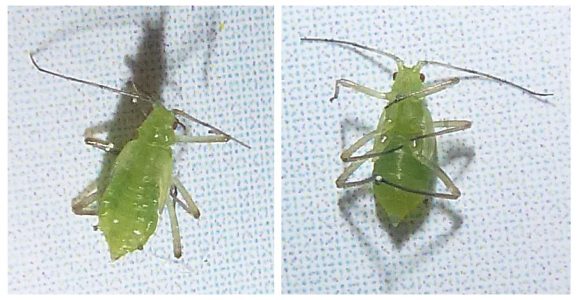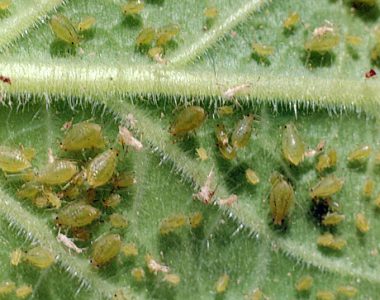In this post, we focus our attention on aphids. You’re likely to cross paths with these insects, so here is some basic information to assist in recognizing them. Two common species include birch aphids and giant conifer aphids. Although an aphid infestation could potentially cause some stunting in your garden, these two particular types of aphids are not believed to be much of a pest.
Aphids are best managed with preventative measures, but if necessary, there are strategies for managing them if an infestation is underway. Below, I will describe a couple of common species, and then present some effective management strategies.
Aphids in Alaska
Aphids can reproduce parthenogenetically, without mating, and if the conditions persist unchecked, can lead to an infestation in your garden. Their life cycles are complex and not well understood, but typically their eggs survive the winter and hatch in the springtime as females.
Aphids have the potential to cause problems as they are known to suck the sap from their host plants and secrete large amounts of honeydew. Aphids are also capable of transmitting diseases and virus. Flowering plants and fruits could become deformed and potentially result in galls to form on roots and leaves. Common types of aphids in Alaska include the birch aphid and the giant conifer aphid.
Proper identification is the first step in managing a pest problem. Below, I will describe a couple of common aphids that you may encounter. If you still have questions, lucky for you (us!), we have an excellent resource available through our University of Alaska Fairbanks (UAF) Cooperative Extension Service: Integrated Pest Management Program. This site offers some background information and even a ‘sample submission’ option to submit your questions and pictures to a ‘Citizen Scientist’ who will assist you with identifying pests.
Birch Aphid
According to “Insects and Disease of Alaskan Forests (Edward H. Holsten), ‘birch aphids’ host is the paper birch tree. They are a non-native species that is believed to have originated from Europe in the 1800s. Their is only one species of birch aphid in Alaksa.
My property is filled with paper birch trees, so it is no surprise that I witnessed birch aphids in my trees. My home sits at the top of hill and can experience windy conditions quite often.
According to this USDA report, birch aphids are dull green and about an 1/8th inch long, soft-bodied, pear shaped, and have long legs. They can be present both winged or wingless forms. Several generations of aphids can be produced quickly. The first few generations will typically be wingless females, but winged aphids will likely show up by mid summer or fall. The winged aphids can sometimes be males that do mate with the females to produce more eggs to complete the over-winter cycle again.

Giant Conifer Aphids
According to ‘Insects and Disease of Alaskan Forests’ (Edward H. Holsten), conifer aphids are characterized by their dark color and long legs, approximately 5mm long. The origin of giant conifer aphids is not well understood. Because of lacking evidence of their origin they are considered a native species. Their is believed to be at least two species of giant conifer aphids in Alaska, but likely more than that.
Giant conifer aphids’ eggs are black and commonly laid on needles on their host tree (i.e. Sitka and White Spruce). Large populations can stunt the growth of plants. They also secrete a sticky honeydew that can result in a dark colored mold to develop.

Aphid Infestation

Preventing an Infestation
I would like to highlight some effective IPM strategies and controls as long-term solutions for preventing aphids from wreaking havoc on your garden. Our goal in solving the problem of an aphid infestation is to use methods of control that do not have a detrimental effect to other organisms. With the right controls and a healthy ecosystem, you can set up your garden for success!
Use companion plants to attract beneficial insects and organisms into your garden area. You can plant aphid-repelling plants in your garden such as onions, chives, garlic, and radishes. Another strategy is to plant aphid-attracting plants to attract aphids away from your garden area. An example type of aphid-attracting plant is nastursium.
Another strategy is to attract beneficial insects to the garden to feast on these pests. Ladybugs and lacewings love to eat aphids.
Managing an Active Infestation
If an infestation has already started to cause problems in your garden, there are some immediate steps you can take to try and mitigate their presence. Example products that have minimal detrimental effects to other organisms include insecticidal soap and neem oil. Both of these products are available at most garden stores and can be sprayed directly on your plants. Insecticidal soaps kill soft-bodied insects such as caterpillar larvae and aphids without harming their hard-bodied predators such as wasps, ants, or ladybugs. You can also hand-pick the aphids from your plants, or use high powered sprayer or hose to spray tree branches or leave petals to control aphids. These methods can help to reduce an outbreak and get you back on track to developing a healthy ecosystem in your garden. From here, you could enact more long-term solutions like the ones mentioned above (companion planting and attracting other beneficial insects).
About srrobinson
Twitter •
Dear SR,
Thank you for your blog post. Here’s a proven home remedy for ATTRACTING LADYBUGS TO WHERE APHIDS ARE A PROBLEM:
Mix 5 ounces sugar into 1 quart of water and apply using a watering can to plants with aphids.
Research at Utah State University noted that a solution of sugar water applied at the center of an alfalfa field increased ladybug numbers in 1 -2 days by 200% to 1300%. (Printed in Entomophaga Vol. 42 2)
🙂
Awesome. Thanks for the information. I will give this a try next year!